Harding Surname Ancestry ResultsOur indexes 1000-1999 include entries for the spelling 'harding'. In the period you have requested, we have the following 2159 records (displaying 1291 to 1300): Single Surname Subscription | | | Buying all 2,159 results of this search individually would cost £12,654.00. But you can have free access to all 2,159 records for a year, to view, to save and print, for £100. Save £12,554.00. More... |
These sample scans are from the original record. You will get scans of the full pages or articles where the surname you searched for has been found. Your web browser may prevent the sample windows from opening; in this case please change your browser settings to allow pop-up windows from this site.  Inhabitants of Newington in Surrey
(1851) Inhabitants of Newington in Surrey
(1851)
The 1851 census return for St Mary Newington, Surrey, registration district: St Peter Walworth sub-district: enumeration district 22: described as: "All that Part of the Parish of St. Mary Newington, which Comprises East St. (North side) to John St., John St. (both sides) Including Tatums Place, Tatums Court, Ballards Yard, Woods Buildings, & Aldred Place to boundary". This area lay in the ecclesiastical district of St Peter Walworth, and in the borough of Lambeth. HO 107/1567. The addresses listed in the actual returns are East Street (six households); 1 to 4 Smiths Buildings, East Street; 1 to 12 Bedford Row; 1 to 17 Woods Buildings (including tan yard); 1 to 18 Alfred Place; 1 to 6 Sion Place; 1 to 21 and 36 to 44 John Street (including yards); 1 to 3 Tatum's Court; 3 to 6 Woods Buildings; 1 to 3 Ballards Yard; Park Place; 2 to 13 Tatum's Place; and 1 to 14 Ludbroke Place.HARDING. Cost: £4.00.  | Sample scan, click to enlarge

|  Inhabitants of Newington in Surrey
(1851) Inhabitants of Newington in Surrey
(1851)
The 1851 census return for St Mary Newington, Surrey, registration district: St Peter Walworth sub-district: enumeration district 8: described as: "All that Part of the Parish of St. Mary Newington, which Comprises Walworth Common (south side) from Walworth Road to Providence St., Including West side of Providence St., Appleton Place, Charles St., Pilgrim St. (both sides), Port St. (both sides), Milk St. (both sides) and Red Lion Row". This area lay in the ecclesiastical district of St Peter Walworth, and in the borough of Lambeth. HO 107/1567. The addresses listed in the actual returns are 1 to 7 Red Lion Row, Grosvenor Park; 1 to 7 Port Place, Walworth Common; 1 to 27 Milk Street; 1 to 6 Port Place; 2 to 24 Port Street; Port House, Port Street; 1 to 32 Pilgrim Streeet; 1 to 3 Bucknell Place; 1 to 7 Charles Street; 1 to 4 Nuns Place; 1 to 5 Appleton Place; 1 to 6 Boytons Place; 1 to 6 Portland Terrace; and 9 to 18 Providence Street. HARDING. Cost: £4.00.  | Sample scan, click to enlarge

|  Inhabitants of Newington in Surrey
(1851) Inhabitants of Newington in Surrey
(1851)
The 1851 census return for St Mary Newington, Surrey, registration district: St Peter Walworth sub-district: enumeration district 6: described as: "All that Part of the Parish of St. Mary Newington, which Comprises the south side of Beresford St., West side of Walworth Road to Grosvenor St. Including Brunswick Terrace, North Side of Grosvenor St., and North Terrace". HO 107/1567. This area lay in the ecclesiastical district of St Peter Walworth, and in the borough of Lambeth. The addresses listed in the actual returns are 1 to 3 Canterbury Terrace; 1 to 3 Oliver Cottages; 1 to 29 Flood's Terrace; Queen's Cottages; 1 and 2 Beresford Cottage; Lion Cottage;1 and 2 Rose Cottage(s); 1 to 34 Beresford Terrace; 1 to 28 Kennington Street; 1 to 8 Beresford Street; Brown's Cottage; 1 to 4 Williams Place; Barwick's Stables; 1 to 6 Williams Place (South); 1 to 16 Brunswick Terrace; 1 to 3 Brunswick Place; Brunswick Cottage; Grosvenor Cottage; 1 to 5 Grosvenor Place; 1 to 19 Grosvenor Street; and 1 to 6 North Terrace.HARDING. Cost: £4.00.  | Sample scan, click to enlarge

|  Inhabitants of Southwark in Surrey
(1851) Inhabitants of Southwark in Surrey
(1851)
The 1851 census return for St George the Martyr, Southwark, registration district: London Road sub-district: enumeration district 15: described as: "Webber Street commencing at Wood's (corner of Webber Row) to Ross's the end of Parish - Barron's Place (both sides) - John's Buildings - Herbert's Buildings - Chester Place - Barron's Court - Laurie Terrace - Barkham Terrace - King Edward Street (both sides) - and Yorkshire School." This area lay in the parish of St George the Martyr, Southwark. The addresses listed in the actual returns are 1 to 6 and 20 Webber Street, 1 to 28 Herbert's Buildings, Half Way House, 1 to 7 Johns Terrace, 1 to 20 Barrons Place, 1 to 8 Johns Buildings, 1 to 5 Chester Place, 1 to 6 Barron's Court, 1 to 23 Laurie Terrace, 1 to 17 Barkham Terrace (with East Lodge and West Lodge), 1 to 11 King Edward Street, 1 to 16 Price's Terrace, and the Yorkshire Society's School (Westminster Road).HARDING. Cost: £4.00.  | Sample scan, click to enlarge

| Insolvents imprisoned for debt in England and Wales
(1851)
Perry's Bankrupt and Insolvent Gazette, issued monthly, included brief notices of insolvents' estates surrendered to assignees. Each entry gives the surname and christian name of the insolvent, trade and address, followed by the name of the prison. This is the index to the names of the insolvents, from the issues from January to December 1851.HARDING. Cost: £6.00.  | Sample scan, click to enlarge

| Insolvents in England and Wales
(1851)
Perry's Bankrupt and Insolvent Gazette, issued monthly, included lists of insolvencies and stages in the process whereby the insolvents petitioned for release from debtors' prison. The insolvent is generally referred to by name (surname first), address and trade. This is the index to the names of the insolvents, from the issues from January to December 1851.HARDING. Cost: £6.00.  | Sample scan, click to enlarge
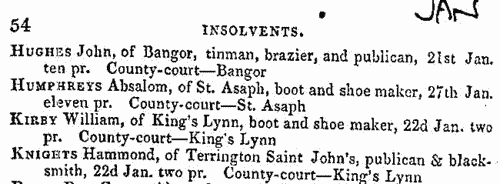
| Pupil Teachers in Cornwall: Girls
(1851)
The Committee of Council on Education awarded annual grants for the training and support of pupil teachers and stipendiary monitors in schools in England, Wales, Scotland, the Isle of Man and the Channel Islands. Pupil teachers started training between the ages of 13 and 15, and 'must not be subject to any bodily infirmity likely to impair their usefulness as Pupil Teachers, such as scrofula, fits, asthma, deafness, great imperfections in the sight or voice, the loss of an eye from constitutional disease, or the loss of an arm or leg, or the permanent disability of either arm or leg, curvature of the spine, or a hereditary tendency to insanity'.
They also had to obtain certificates from the managers of the school (and their clergyman, in the case of Church of England schools) as to their moral character and that of their family; good conduct; punctuality, diligence, obedience, and attention to duty; and attentiveness to their religious duties.
This detailed statement in the annual report of the committee for the year ending 31 October 1851 lists schools by county, giving:
1. Name and Denomination of School, with these abbreviations - B, British and Foreign School Society; F. C., Free Church of Scotland; H. C., Home and Colonial School Society; N., National Society, or connected with the Church of England; R. C., Roman Catholic Poor-School Committee; Wesn., Wesleyan Methodist.
2. Annual grants conditionally awarded by the committee in augmentation of teachers' salaries, and in stipends to apprentices, and gratuities to teachers.
3. Month in which annual examination was to be held.
4. Names of apprentices, giving surname and initials, and year of apprenticeship. Stipendiary monitors are indicated by (S. M.).HARDING. Cost: £6.00.  | Sample scan, click to enlarge
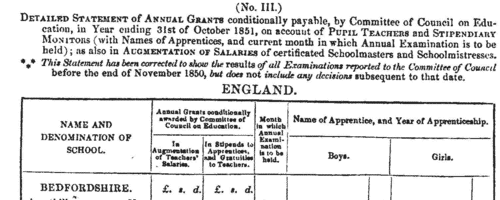
| Pupil Teachers in Hampshire: Boys
(1851)
The Committee of Council on Education awarded annual grants for the training and support of pupil teachers and stipendiary monitors in schools in England, Wales, Scotland, the Isle of Man and the Channel Islands. Pupil teachers started training between the ages of 13 and 15, and 'must not be subject to any bodily infirmity likely to impair their usefulness as Pupil Teachers, such as scrofula, fits, asthma, deafness, great imperfections in the sight or voice, the loss of an eye from constitutional disease, or the loss of an arm or leg, or the permanent disability of either arm or leg, curvature of the spine, or a hereditary tendency to insanity'.
They also had to obtain certificates from the managers of the school (and their clergyman, in the case of Church of England schools) as to their moral character and that of their family; good conduct; punctuality, diligence, obedience, and attention to duty; and attentiveness to their religious duties.
This detailed statement in the annual report of the committee for the year ending 31 October 1851 lists schools by county, giving:
1. Name and Denomination of School, with these abbreviations - B, British and Foreign School Society; F. C., Free Church of Scotland; H. C., Home and Colonial School Society; N., National Society, or connected with the Church of England; R. C., Roman Catholic Poor-School Committee; Wesn., Wesleyan Methodist.
2. Annual grants conditionally awarded by the committee in augmentation of teachers' salaries, and in stipends to apprentices, and gratuities to teachers.
3. Month in which annual examination was to be held.
4. Names of apprentices, giving surname and initials, and year of apprenticeship. Stipendiary monitors are indicated by (S. M.).HARDING. Cost: £6.00.  | Sample scan, click to enlarge
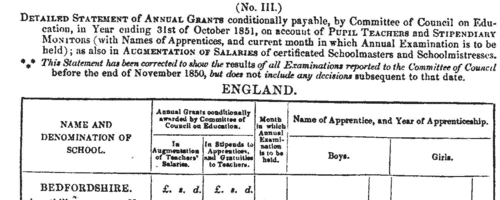
| Pupil Teachers in Hampshire: Girls
(1851)
The Committee of Council on Education awarded annual grants for the training and support of pupil teachers and stipendiary monitors in schools in England, Wales, Scotland, the Isle of Man and the Channel Islands. Pupil teachers started training between the ages of 13 and 15, and 'must not be subject to any bodily infirmity likely to impair their usefulness as Pupil Teachers, such as scrofula, fits, asthma, deafness, great imperfections in the sight or voice, the loss of an eye from constitutional disease, or the loss of an arm or leg, or the permanent disability of either arm or leg, curvature of the spine, or a hereditary tendency to insanity'.
They also had to obtain certificates from the managers of the school (and their clergyman, in the case of Church of England schools) as to their moral character and that of their family; good conduct; punctuality, diligence, obedience, and attention to duty; and attentiveness to their religious duties.
This detailed statement in the annual report of the committee for the year ending 31 October 1851 lists schools by county, giving:
1. Name and Denomination of School, with these abbreviations - B, British and Foreign School Society; F. C., Free Church of Scotland; H. C., Home and Colonial School Society; N., National Society, or connected with the Church of England; R. C., Roman Catholic Poor-School Committee; Wesn., Wesleyan Methodist.
2. Annual grants conditionally awarded by the committee in augmentation of teachers' salaries, and in stipends to apprentices, and gratuities to teachers.
3. Month in which annual examination was to be held.
4. Names of apprentices, giving surname and initials, and year of apprenticeship. Stipendiary monitors are indicated by (S. M.).HARDING. Cost: £6.00.  | Sample scan, click to enlarge
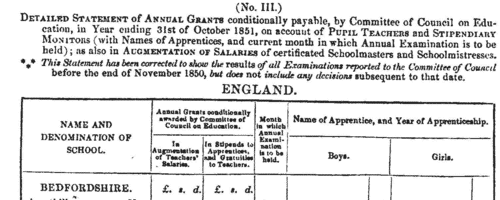
| Pupil Teachers in Middlesex: Boys
(1851)
The Committee of Council on Education awarded annual grants for the training and support of pupil teachers and stipendiary monitors in schools in England, Wales, Scotland, the Isle of Man and the Channel Islands. Pupil teachers started training between the ages of 13 and 15, and 'must not be subject to any bodily infirmity likely to impair their usefulness as Pupil Teachers, such as scrofula, fits, asthma, deafness, great imperfections in the sight or voice, the loss of an eye from constitutional disease, or the loss of an arm or leg, or the permanent disability of either arm or leg, curvature of the spine, or a hereditary tendency to insanity'.
They also had to obtain certificates from the managers of the school (and their clergyman, in the case of Church of England schools) as to their moral character and that of their family; good conduct; punctuality, diligence, obedience, and attention to duty; and attentiveness to their religious duties.
This detailed statement in the annual report of the committee for the year ending 31 October 1851 lists schools by county, giving:
1. Name and Denomination of School, with these abbreviations - B, British and Foreign School Society; F. C., Free Church of Scotland; H. C., Home and Colonial School Society; N., National Society, or connected with the Church of England; R. C., Roman Catholic Poor-School Committee; Wesn., Wesleyan Methodist.
2. Annual grants conditionally awarded by the committee in augmentation of teachers' salaries, and in stipends to apprentices, and gratuities to teachers.
3. Month in which annual examination was to be held.
4. Names of apprentices, giving surname and initials, and year of apprenticeship. Stipendiary monitors are indicated by (S. M.).HARDING. Cost: £6.00.  | Sample scan, click to enlarge
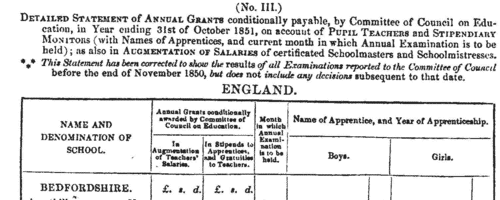
|
Research your ancestry, family history, genealogy and one-name study by direct access to original records and archives indexed by surname.
|













